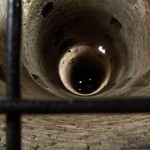The Roman Well in the Upper Town is not a structure from ancient times, but is much younger, dating from the first half of the 18th century. The name was given to it by the people of Belgrade in the 19th century, emphasising its age and mysticism with the adjective Roman. At the time it was built, the well was located in a moat, in front of an already demolished medieval castle. There is a document in the War Archives in Vienna that testifies that the construction of the well was completed in 1731 and that a mechanism for extracting water was built into it at that time. The building has been preserved to this day in its original form.
The well is located within an underground room, from which a vaulted corridor leads to the Royal Gate and is characterised by its impressive size — it is 3.40 metres wide and 35 metres high from top to bottom. However, the depth to which the water reaches is only 21 metres, of which 17 metres is the water itself and 4 metres is the height of the rubble located at the bottom, which serves as a purification layer.
At the time it was built, this well was one of the best achievements of military architecture. Around its inner wall, there are two rows of spiral steps, thanks to which it is possible to descend to a depth of 35 metres, corresponding approximately to the former water level. The stairs are interconnected by a semicircular corridor, which made it much easier to move around the well when drawing water. Today, the well is not used, so the water level is much higher and the steps are partially submerged.
During the excavation of the well bottom, which was carried out on the eve of the Second World War, it was determined that the well was not connected to the Sava River by a corridor, as was previously believed. However, the fact that the builders originally probably had such an intention is evidenced by the beginning of a corridor that exists at the bottom of the well. The corridor was dug through a rock about two metres long, but it remains unfinished.





